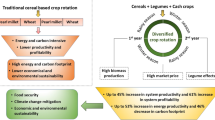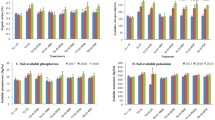Abstract
Reducing the carbon footprint and increasing energy use efficiency of crop rotations are the two most important sustainability issues of the modern agriculture. Present study was undertaken to assess economics, energy, and environmental parameters of common diversified crop rotations (maize-tomato, and maize-toria-wheat) vis-a-vis traditional crop rotations like maize-wheat, maize + ginger and rice-wheat of the north-western Himalayan region of India. Results revealed that maize-tomato and maize + ginger crop rotations being on par with each other produced significantly higher system productivity in terms of maize equivalent yield (30.2–36.2 t/ha) than other crop rotations (5.04–7.68 t/ha). But interestingly in terms of energy efficiencies, traditional maize-wheat system (energy efficiency 7.9, human energy profitability of 177.8 and energy profitability of 6.9 MJ/ha) was significantly superior over other systems. Maize + ginger rotation showed greater competitive advantage over other rotations because of less consumption of non-renewable energy resources. Similarly, maize-tomato rotation had ability of the production process to exploit natural resources due to 14–38 % less use of commercial or purchased energy sources over other crop rotations. Vegetable-based crop rotations (maize + ginger and maize-tomato) maintained significantly the least carbon footprint (0.008 and 0.019 kg CO2 eq./kg grain, respectively) and the highest profitability (154,322 and 274,161 Rs./ha net return, respectively) over other crop rotations. As the greatest inputs of energy and carbon across the five crop rotations were nitrogen fertilizer (15–29 % and 17–28 %, respectively), diesel (14–24 % and 8–19 %, respectively) and irrigation (10–27 % and 11–44 %, respectively), therefore, alternative sources like organic farming, conservation agriculture practices, soil and water conservation measures, rain water harvesting etc. should be encouraged to reduce dependency of direct energy and external carbon inputs particularly in sub-Himalayas of India.


Similar content being viewed by others
References
C.S.W.C.R.T.I. (2014). http://www.cswcrtiweb.org/index1.html?Technology.html Assessed on 12.08.2014 at 3.00 pm.
Choudhary, V. K., & Suresh, K. P. (2013). Crop and water productivity, profitability and energy consumption pattern of a maize-based crop sequence in the North Eastern Himalayan Region, India. Archives of Agronomy and Soil Sciences, 59(5), 653–669. http://dx.doi.org/10.1080/03650340.2012.665992.
Choudhary, A. K., Pooniya, V., Kumar, A., Sepat, S., Bana, R. S., & Jat, S. L. (2013). Scope and potential of maize (Zea mays L.) in North-Western Himalayas. In A. Kumar, S. L. Jat, R. Kumar, & O. P. Yadav (Eds.), Maize production systems for improving resource-use efficiency and livelihood security (pp. 69–73). Pusa Campus, New Delhi- 110 012: Directorate of Maize Research.
Cochran, W.G., & Cox G.M. (1957). Experimental Designs. (2nd ed.). Wiley 53, 43–50
Devasenapathy, P., Senthilkumar, G., & Shanmugam, P. M. (2009). Energy management in crop production. Indian Journal of Agronomy, 54(1), 80–90.
Ghorbani, R., Mondani, F., Amirmoradi, S., Feizi, H., Khorramdel, S., Teimouri, M., Sanjani, S., Anvarkhah, S., & Aghel. (2011). A case study of energy use and economical analysis of irrigated and dryland wheat production systems. Applied Energy, 88, 283–288. doi:10.1016/j.apenergy.2010.04.028.
Ghosh, B. N., Dogra, P., Sharma, N. K., Alam, N. M., Singh, R. J., & Mishra, P. K. (2015). Effects of resource conservation practices on productivity, profitability and energy budgeting in maize–wheat cropping system of Indian sub-Himalayas. Proceedings of the National Academy of Sciences, India Section B: Biological Sciences. doi:10.1007/s40011-015-0492-2.
Grassinia, P., Thorburnb, J., Burrc, C., & Cassman, K. G. (2011). High-yield irrigated maize in the Western U.S. Corn Belt: I. On-farm yield, yield potential, and impact of agronomic practices. Field Crops Research, 120(1), 142–150. doi:10.1016/j.fcr.2010.09.012.
Headau, N. K., Tuti, M. D., Stanley, J., Mina, B. L., Agarwal, P. K., Bisht, J. K., & Bhatt, J. C. (2014). Energy -use efficiency and economic analysis of vegetable cropping sequences under greenhouse condition. Energy Efficiency, 7(3), 507–515. doi:10.1007/s12053-013-9239-1.
Heidari, M. D., & Omid, M. (2011). Energy use patterns and econometric models of major greenhouse vegetable productions in Iran. Energy, 36, 220–225. doi:10.1016/j.energy.2010.10.048.
I.P.C.C. (2006). IPCC guidelines for national greenhouse gas inventories. In H. A. S. Eggleston, L. Biennia, K. Miwa, T. Negara, & K. Tanabe (Eds.), Prepared by National Greenhouse Gas Inventories Programme. IGES, Japan: Eggleston Published.
Jayne, T. S., Chamberlin, J., & Headey, D. D. (2014). Land pressures, the evolution of farming systems, and development strategies in Africa: a synthesis. Food Policy, 48, 1–17. http://dx.doi.org/10.1016/j.foodpol.2014.05.014.
Lal, R. (2004). Carbon emission from farm operations. Environmental International, 30, 981–990. doi:10.1016/j.envint.2004.03.005.
Loucks, O.L., & D’Alessio, A. (1975). Energy Flow and Human Adaptation. A Summary of Ecosystem Studies. The Institute of Ecology, Madison, WI
Ma, B. L., Liang, B. C., Biswas, D. K., Morrison, M. J., & McLaughlin, N. B. (2012). The carbon footprint of maize production as affected by nitrogen fertilizer and maize-legume rotations. Nutrient Cycling in Agroecosystem, 94, 15–31. doi:10.1007/s10705-012-9522-0.
Marland, G., West, T. O., Schlamadinger, B., & Canella, L. (2003). Managing soil organic carbon in agriculture: the net effect on green gas house emissions. Tellus, 55B, 613–621.
Martin, J. F., Diemont, S. A. W., Powell, E., Stanton, M., & Levy-Tacher, S. (2006). Emergy evaluation of the performance and sustainability of three agricultural systems with different scales and management. Agriculture Ecosystem and Environment, 115(1–4), 128–140. doi:10.1016/j.agee.2005.12.016.
Nautiyal, S., Kaechele, H., Rao, K. S., Maikhuri, R. K., & Saxena, K. G. (2007). Energy and economic analysis of traditional versus introduced crops cultivation in the mountains of the Indian Himalayas: a case study. Energy, 32, 2321–2335. doi:10.1016/j.energy.2007.07.011.
Pimentel, D. (1980). Energy inputs for the production, formulation, packaging, and transport of various pesticides. In D. Pimentel (Ed.), Handbook of energy utilization in agriculture (pp. 45–55). Boca Raton, FL: CRC.
Pimentel, D., Hurd, L. E., Belloti, A. C., Forester, M. J., Oka, I. N., & Sholes, O. D. (1973). Food production and the energy crisis. Science, 102, 443–449.
Samra, J.S., Dhyani, B.L. & Sharma, A.R. (1999). Problems and prospectus of natural resource management in Indian Himalayas—a base paper. Hill and Mountain Agro-ecosystem Directorate, Dehradun (NATP).pp 146.
Sati, V. P. (2012). Agricultural diversification in the Garhwal Himalaya: a spatio-temporal analysis. Sustainable Agriculture Research, 1(1), 77–86. doi:10.5539/sar.v1n1p77.
Sharma, N. K., Ghosh, B. N., Mandal, D., Singh, R. J., & Mishra, P. K. (2014). Conservation agriculture for resource conservation in north-western Himalaya region. In J. Somasundaram et al. (Eds.), Conservation agriculture for carbon sequestration and sustaining soil health (pp. 105–126). New Delhi, India: New India.
Singh, R. J. (2012). Weed management in irrigated wheat (Triticum aestivum) with special reference to buttercup weed (Ranunculus spp) in north-west Himalayas. Indian Journal of Agricultural Sciences, 82(8), 706–710.
Singh, R. J., & Ahlawat, I. P. S. (2011). Productivity, competition indices and nutrients dynamics of Bt cotton (Gossypium hirsutum L.) - groundnut (Arachis hypogaea L.) intercropping system using different fertility levels. Indian Journal of Agricultural Sciences, 81(7), 606–611.
Singh, R. J., & Ahlawat, I. P. S. (2015). Energy budgeting and carbon footprint of transgenic cotton-wheat production system through peanut intercropping and FYM addition. Environmental Monitoring and Assessment, 187(5), 1–16. doi:10.1007/s10661-015-4516-4.
Singh, R. J., Ghosh, B. N., Sharma, N. K., Patra, S., Dadhwal, K. S., & Mishra, P. K. (2016). Energy budgeting and emergy synthesis of rainfed maize-wheat rotation system with different soil amendment applications. Ecological Indicators, 61(2), 753–765. doi:10.1016/j.ecolind.2015.10.026.
Tuti, M. D., Ved, P., Pandey, B. M., Bhattacharyya, R., Mahanta, D., Bisht, J. K., Kumar, M., Mina, B. L., Kumar, N., Bhatt, J. C., & Srivastva, A. K. (2012). Energy budgeting of colocasia-based cropping system in the Indian sub-Himalayas. Energy, 45, 986–993. http://dx.doi.org/10.1016/j.energy.2012.06.056.
van Groenigen, J. W., Velthof, G. L., Oenema, O., Van Groenigen, K. J., & Van Kessel, C. (2010). Towards an agronomic assessment of N2O emissions: a case study for arable crops. European Journal of Soil Sciences, 61, 903–913. doi:10.1111/j.1365-2389.2009.01217.x.
West, T. O., & Marland, G. (2002). A synthesis of carbon sequestration, carbon emissions, and net carbon flux in agriculture: comparing tillage practices in the United States. Agriculture Ecosystem and Environment, 91, 217–232. doi:10.1016/S0167-8809(01)00233-X.
Acknowledgments
The authors express sincere thanks to Directors, ICAR-IISWC, Dehradun, ICAR-NBSS&LUP, Nagpur and ICAR-NAARM, Hyderabad for their kind guidance and encouragement during the course of this study. They are also grateful to the field staff and farmers of the study area for their assistance in completing this study. They are grateful to the anonymous reviewers and editors for comments and suggestions for improvement of the manuscript.
Author information
Authors and Affiliations
Corresponding author
Ethics declarations
The authors declare that they have no conflict of interest.
Electronic supplementary material
Below is the link to the electronic supplementary material.
Rights and permissions
About this article
Cite this article
Singh, R.J., Meena, R.L., Sharma, N.K. et al. Economics, energy, and environmental assessment of diversified crop rotations in sub-Himalayas of India. Environ Monit Assess 188, 79 (2016). https://doi.org/10.1007/s10661-015-5085-2
Received:
Accepted:
Published:
DOI: https://doi.org/10.1007/s10661-015-5085-2




